Many major makers in China have well-equipped testing facilities
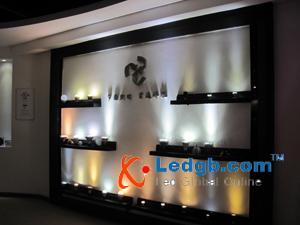
Dowin's unique lens design widens diffusion angles of LED bulbs to over 180 degree.
On an August morning this year, Simon Wang, general manager of Dowin Optoelectronic Co. who was inspecting the pilot production of LED light emitting diode lamps at his factory in an incubator center of the the Guokai Digital Media Industrial Park in Nanhai, Guangdong Province, thought to himself that it was about time to start mass production.
Besides being a physics specialist trained at the prestigious Sun Yat-Sen University SYSU in mainland China, Wang is one of the mainland's growing number of lighting entrepreneurs toiling to break free of low-margin manufacturing.
Having set up Dowin in 2004, Wang works with around 20 well trained engineers noted for having on average 10 years of industry experience and have won a slew of patented designs. On the team are a British designer and several Chinese designers trained in Japan, and we also work with Taiwanese packager HLEIO Opto and Taiwan's ITRI [Industrial Technology Research Institute] as well as SYSU's optoelectronics laboratories, says Wang, who is a member of the China Solid State Lighting Alliance and has visited Taiwan's LED organizations many times while attending cross-strait technology forums.
Backed by Gov't and Academia
Funded by the Nanhai People's Government of Foshan, Guangdong Province, the university's Fushan laboratory has been Dowin's major technology source. The laboratory is led by Wang Gan, a prominent optoelectronics professor in China teaching LED physics at the SYSU.
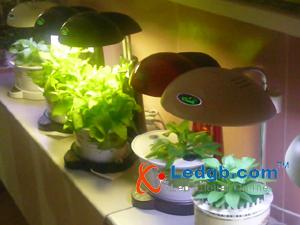
MKD's grow lights brim with features.
Outside technological support has enabled Dowin to develop several patented designs, including a sub-10W dimmable E27 bulb; while unique lens design allows this bulb to emit light at 180-degree-plus diffusion with 500 lumens of brightness, making it an ideal replacement for 60W incandescent lamp. This bulb has won CE and UL approvals, reportedly making Dowin China's first UL-certified LED-lighting manufacturer. Another is an unorthodox cooling design using air cushion to isolate heat from light source from that from electrical power, effectively keeping ambient temperature within 70 C. Also unique is a nano-grade packaging material that claims thermal conductivity at a staggering 300 W/m.K.
According to Wang, these cooling technologies have been proven in field tests to keep ambient temperature of LED lighting systems to below 80-82 C.
Our products meet U.S. Department of Energy's minimum 30,000 hours for commercial use and 20,000 hours for household use, Wang says, whose firm supplies E27 light bulbs, T8 tubes, PA38 spotlights, track lights and panel lights rated from 1 watt to 30 watts as well as 100W high-bay lights. The maker uses packages from Citizen, Sharp and Cree to assure long life spans and avoid patent lawsuits, as well as having worked with LightTech of the United States on power designs.
Dowin's good quality and cost efficiency convinced advertising agents to contract the building of several Coca Cola and Nokia LED billboards in Europe.
Currently, Dowin owes its cost-efficient production to using chip-on-board COB packaging that eliminates the thermal-buffer layer between chip and circuit board. We use other packaging methodologies besides COB to keep cost down, says Wang, who also believes, after 20 years in the business, COB is an ideal multichip packaging solution to minimize complexity and achieve good cooling.
With cost efficiency improving gradually, Wang hopes the company can soon bring down the cost of a 7W LED bulb, of the same brightness as 10W CCFL cold cathode fluorescent lamp to only US$10.
Dowin's other advantages, according to Wang, include unique product designs, collaboration with Western brand-name suppliers, meeting standards set by the U.S. Department of Energy, and built-to-order manufacturing.
Now, we hope to complement our supply chain by integrating with Taiwan's packagers and chipmakers to scale up production to further cut cost, he says.
Diversification
Mo Hezhao, who founded Mingkeda Industries Co., Ltd. MKD in 1984 in Heshan to make desk lamps, has raised profit by using its desk lamp technology to make cultivation lights for hydroponic systems.
The company began grow-light production in 2005, when it was contracted by AeroGrow International of the United States to supply tooling and molds for the lights. As the world's first kitchen-garden appliance, the light received the Certificate of Excellence Award during the International Home & Housewares Show 2006 in Chicago, according to Mo.
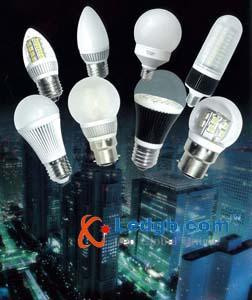
Shenzhen Hipower's LED lamps feature Taiwan-developed technologies.
Claiming his company and AeroGro are the world's first manufacturers to move gardening into living rooms, Mo says, We once sold 1,000 of the grow lights within 10 minutes on a TV shopping channel. Now, the lights are promoted online.
Having focused on R&D of grow lights since its establishment in 2002, AeroGro in 2005 chose us as manufacturing partner after approaching three Chinese manufacturers including an aquarium manufacturer, Mo says. Now, his company holds shares in AeroGrow.
The grow light emits ideal wavelengths to cultivate salad greens, herbs, flowers, strawberry, tomato and peppers, all of which ripen in 28 days guaranteed.
Laden with features, the light has automatic on-off, nutrient addition, energy efficiency 26W fluorescent lamp producing 1,450 lumens for at least 6,000 hours full daylight spectrum, and creates near-perfect rainforest growing environment.
The hydroponic planter has seven seed pods. Made out of some special material, the fertilized seed beds grow without mold, thereby winning it a patent.
The grow light was a formidable product to develop. The hardest challenges came from the lamp, fertilizer bed and reflector mechanism, recalls Mo. To find the optimum wavelength for plant growth called for Mo's company to try phosphor powders of various wavelengths for half a year. LED works but is expensive. The 3U lamp we use now costs only US$1.6, he notes.
It was also exhausting to find the right material for the seed pods that would not grow mold, but, after experimenting in the lab, the right one was finally found, he says.
As North America and Europe have been the major markets of the grow lights, MKD's sales of the lights plunged after the outbreak of the financial crisis in 2007. In the heyday, we had orders for least 100,000 lights a year, Mo says. Now, his company plans to tap the China market. We will also produce fertilizers to use with the lights in China, he adds.
MKD recently added LED desk lamps and solarium lamps to its product line, hoping to snatch more orders for high-margin lamps. Most of its solarium lamps are rated 90W while the desk lamps are mainly rated above 10W.
The maker's intelligent lens design achieves LED light without unwanted overlapping shadows.
For now, we sell half our lights for people and the other half for plants, Mo says.
Relying on Taiwan's LED Sector
Gordon Zhou, chief executive officer of Shenzhen Hipower Optoelectronic Co., Ltd., works closely with Taiwan's LED industry, currently the world's largest supplier of such devices by volume, is the formula used to distinguish his company from low-end peers at home. We took on former Everlight engineers to run the packaging factory when we opened it in 2006, Zhou recalls. Everlight Electronics Co., Ltd. is Taiwan's No.1 LED packager.
These Taiwan-trained engineers have helped the company build capability to make dual-in-line DIP and surface-mount-device SMD packages using chip-on-board COB technology for its 2,000 types of LED lights, which are rated from one to 100W and available for automobiles, households, and commercial premises.
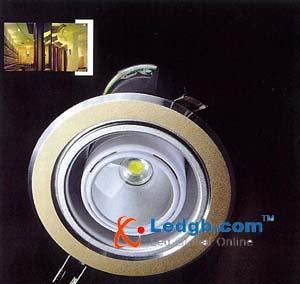
Century Optoelectronics' LED lamps rely on Taiwan technologies.
Shenzhen Hipower uses mostly chips from Epistar Inc. and Huga Optotech Inc., as well as works with LED players Nichia, Cree, Sharp and Citizen.
Each month, the company's 800 employees put out 600,000 LED lights of various types, most of which go to Europe with CE, TUV, GS and UL certificates, 30,000 hour warranty and three years of after-sale service.
We aim to wield advantages as an LED-lighting manufacturer, Zhou vows, adding that the company never uses common molds to build contracted designs, effectively ensuring design uniqueness of customers' products. The maker has won patents for exterior designs.
Besides having an R&D unit staffed with over 20 engineers adept in electrical-circuit, thermal-dissipation, mechanical-structure and lens design, the maker also tests new products to ensure zero EMI/EMC, accurate color bin and long lifespan.
Shenzhen Hipower, Zhou says, is a well known contract supplier of LED lamps in Europe and has retail giants OBI, B&Q and Carrefour as customers, as well as having opened a branch in Europe. It's not pricing but quality that draws them to buy our products. We are seen as a supplier of mid-range and high-performance products on the market, Zhou says, adding that the company's quality has brought OBI back this year with big orders after suffering loss with low-end suppliers. Quality has enabled us to achieve 30-40% annual growth even during the global downturn, he claims.
Partnering with Taiwan's LED Makers
March Fong, general manager of Century Optoelectronics Technology Co., Ltd., is another LED-lighting manufacturer in China stressing cooperation with Taiwan's LED makers. We use high-power LED chips from Epistar and Taiwan-made multichip packages, building a maximum of 120 chips on each package, Fong boasts.
The company uses Taiwan-made LED devices into its recessed downlights, ceiling lights, sunken lights, track lights, spotlights, pendant lights, light bulbs, roadway lights and wall wash lights.
Using pure aluminum light structure keeps ambient temperature on the company's lighting fixture within 65C, according to Fong. Efficient cooling and chip-packaging solutions allow the company to make outdoor lights rated at maximum 180W and indoor lights up to 60W, which replaces 300W halogen lamps.
Century Optoelectronics began developing LED lights around five to six years ago and started selling the products around a year ago. Fong says the company shipped two million yuan US$298,500 of such lights a month last year on average, over 80% of which go to Europe with CE mark.
Like many of China's heavyweight lighting manufacturers, Century has installed an array of calibration and testing instruments. Tightening standards in the industry compel us to invest on inspection equipment. In China, it's no longer rare to see well equipped testing capability at lighting manufacturers, he stresses.
Multi-feature LED Lights
Frank Wang, chairman of Quasar Light Co. Ltd., an LED-lighting manufacturer headquartered in Hong Kong with a factory in Shenzhen, Guangdong Province, assures reliability by using LED packages from Cree, Lumileds and Everlight, and marketability by achieving average efficacy of 80 lumen per watt, off-the-shelf installation, four-year lifespan, conformity to RoHS, CE, FCC, and UL standards as well as zero flickering and glaring. Furthermore, we build color temperate and color rendering to-order, Wang says.
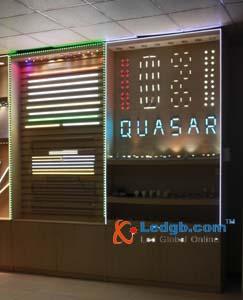
Quasar offers a three-year warranty on staple LED lamps and five-year warranty on specialty products.
Wang ascribes the company's capability to its team of specialists in lighting application, electronics, opto-mechanics, control system and power supply. Also stringent quality control from new product R&D to assembly is crucial, as is our procurers sourcing devices from only quality suppliers, he stresses. The company offers a three-year warranty on staple products and five-year warranty on specialty products.
Wang plans to open offices and warehouses in the United States and Europe in the second half of this year to stay closer to customers and markets. Most of all, doing so will hopefully keep middlemen in distribution from ripping us off us and tarnishing our quality, he adds.
The company offers wide ranging LED lights as MR16, GU10, E27, E17, PAR, ceiling lamps, T8, T5, and cabinet lights, which are specifically for hotels, offices and shops. Wang stays away from the LED streetlight market, stressing that high uncertainty makes involvement risky.
Besides fully testing products in-house for cooling, electrical leakage, voltage, light distribution, and optoelectronics performance before delivery, the maker has over 2,000 customers globally, the major ones being in West Europe, Australia, North America and China. Exports are delivered mostly with customer brands and the Quasar brand in China.
Related News
Photos
More>>trade
- Osram Opto expands LED capacity with 6-inch conversion
- LED phosphor suppliers are affected by China's rare-earth export quotas
- YoungTek posts sequential growth in February revenues, Single Well revenues
- Digital Lumens supplies LED lighting systems for 7 Americold warehouses
- Guangdong to Relax Family Policy by 2030





